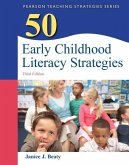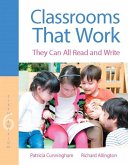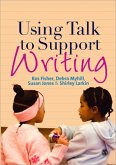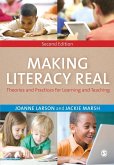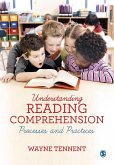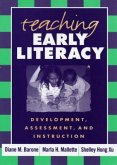T Product Description
The new edition of 50 Literacy Strategies: Step by Step by Gail E. Tompkins is a conveniently organized resource for all elementary and middle school teachers, providing research-based and classroom-tested strategies to develop literacy skills. Everything you need to know to implement, adapt, and enrich each strategy is included in a consistent, easy-to-understand format.
Features + Benefits
Choose the exact strategy you need and implement it with ease. List of Strategies by Instructional Focus in the preface offers another way to find and group strategies for instruction.Each of the 50 instructional strategies outlines:
Instructional Focus: Whether the strategy develops oral language, phonics/phonemic awareness, fluency, vocabulary, comprehension, writing, spelling, and/or content areas
Grade Level: Whether the strategy is appropriate for PreK, K-2, 3-5 or 6-8
Step by Step: As always, clearly outlined steps to implement the strategy
Why and When to Use the Strategy: Sections to help you determine when each activity is most appropriate
Authentic Student Samples: Artifacts from the classroom that model the responses you will receive from students
Adapt instruction to meet the needs of all learners. Both the Differentiating Instruction and Scaffolding English Learners features describe ways to adapt instruction to better serve all learners.
Enlist technology to motivate and engage a tech-savvy student body. Go digital! feature in certain chapters suggest ways to integrate digital technology resources such as podcasts and Inspiration software into the instructional strategy.
Plan instruction that meets national standards. Common Core State Standards for the English Language Arts feature pinpoints the ways individual strategies connect to this important set of standards. For planning purposes, the Common Core Standards matrix on the inside front cover explicitly ties individual strategies with the standards they cover.
Enrich strategies with effective literature. Booklists are features that identify mentor texts teachers can use when teaching a particular instructional strategy.
Backcover
The new edition of 50 Literacy Strategies: Step by Step by Gail E. Tompkins is a conveniently organized resource for teachers, providing research-based and classroom-tested strategies to develop literacy skills. Everything you need to know to implement, adapt, and enrich each strategy is included in a consistent, easy-to-understand format. It's a wonderful resource for elementary and middle school teachers in literacy and language arts!
New to this edition
. New strategies, including Possible Sentences, Process Drama, and RAFT.
. Differentiating Instruction feature in certain chapters describes ways to adapt the instructional strategy to meet the needs of all students.
. Go Digital! feature in certain chapters suggest ways to integrate digital technology resources such as podcasts and Inspiration software into the instructional strategy.
. Common Core State Standards for the English Language Arts feature pinpoints the ways individual strategies connect to this important set of standards.
. Booklists identify mentor texts teachers can use when teaching a particular instructional strategy.
What readers have to say
My students keep this text. This book is captivating to students, and they report that it encourages them to think from various perspectives. It contains helpful text lists, assessments and reproducible materials.
-Angela J. Cox, Georgetown College
There are so many strategies available, the ones listed in the book are some of the major and successful strategies. The Instructional Focus helps to narrow down strategies to what the students want to build their lessons about. Grade Level Designation is very useful, allowing students to make sure they are using appropriate grade-level strategies.
-Deborah A. H. Williams, Wayne State University
The strategies are the essential ones I use in my course. English Language Learner features are a critical component because few of my students have had any interaction with English learners and need significant help
understanding second language literacy.
-Charlotte L. Pass, SUNY Cortland
1. "All About ." Books
2. Alphabet Books
3. Anticipation Guides
4. Author's Chair
5. Book Boxes
6. Book Talks
7. Choral Reading
8. Clusters
9. Collaborative Books
10. Cubing
11. Data Charts
12. Double-Entry Journals
13. Exclusion Brainstorming
14. Gallery Walks
15. Goldilocks Strategy
16. Grand Conversations
17. Guided Reading
18. Hot Seat
19. Interactive Read-Alouds
20. Interactive Writing
21. K-W-L Charts
22. Language Experience Approach
23. Learning Logs
24. Making Words
25. Minilessons
26. Open-Mind Portraits
27. Plot Profiles
28. Possible Sentences
29. Prereading Plan
30. Process Drama
31. Question-Answer-Relationships
32. Questioning the Author
33. Quickwrites
34. Quilts
35. RAFT
36. Readers Theatre
37. Reading Logs
38. Revising Groups
39. Rubrics
40. Shared Reading
41. Sketch-to-Stretch
42. SQ4R
43. Story Boards
44. Story Retelling
45. Sustained Silent Reading
46. Tea Party
47. Venn Diagrams
48. Word Ladders
49. Word Sorts
50. Word Walls
The new edition of 50 Literacy Strategies: Step by Step by Gail E. Tompkins is a conveniently organized resource for all elementary and middle school teachers, providing research-based and classroom-tested strategies to develop literacy skills. Everything you need to know to implement, adapt, and enrich each strategy is included in a consistent, easy-to-understand format.
The new edition of 50 Literacy Strategies: Step by Step by Gail E. Tompkins is a conveniently organized resource for all elementary and middle school teachers, providing research-based and classroom-tested strategies to develop literacy skills. Everything you need to know to implement, adapt, and enrich each strategy is included in a consistent, easy-to-understand format.
Features + Benefits
Choose the exact strategy you need and implement it with ease. List of Strategies by Instructional Focus in the preface offers another way to find and group strategies for instruction.Each of the 50 instructional strategies outlines:
Instructional Focus: Whether the strategy develops oral language, phonics/phonemic awareness, fluency, vocabulary, comprehension, writing, spelling, and/or content areas
Grade Level: Whether the strategy is appropriate for PreK, K-2, 3-5 or 6-8
Step by Step: As always, clearly outlined steps to implement the strategy
Why and When to Use the Strategy: Sections to help you determine when each activity is most appropriate
Authentic Student Samples: Artifacts from the classroom that model the responses you will receive from students
Adapt instruction to meet the needs of all learners. Both the Differentiating Instruction and Scaffolding English Learners features describe ways to adapt instruction to better serve all learners.
Enlist technology to motivate and engage a tech-savvy student body. Go digital! feature in certain chapters suggest ways to integrate digital technology resources such as podcasts and Inspiration software into the instructional strategy.
Plan instruction that meets national standards. Common Core State Standards for the English Language Arts feature pinpoints the ways individual strategies connect to this important set of standards. For planning purposes, the Common Core Standards matrix on the inside front cover explicitly ties individual strategies with the standards they cover.
Enrich strategies with effective literature. Booklists are features that identify mentor texts teachers can use when teaching a particular instructional strategy.
Backcover
The new edition of 50 Literacy Strategies: Step by Step by Gail E. Tompkins is a conveniently organized resource for teachers, providing research-based and classroom-tested strategies to develop literacy skills. Everything you need to know to implement, adapt, and enrich each strategy is included in a consistent, easy-to-understand format. It's a wonderful resource for elementary and middle school teachers in literacy and language arts!
New to this edition
. New strategies, including Possible Sentences, Process Drama, and RAFT.
. Differentiating Instruction feature in certain chapters describes ways to adapt the instructional strategy to meet the needs of all students.
. Go Digital! feature in certain chapters suggest ways to integrate digital technology resources such as podcasts and Inspiration software into the instructional strategy.
. Common Core State Standards for the English Language Arts feature pinpoints the ways individual strategies connect to this important set of standards.
. Booklists identify mentor texts teachers can use when teaching a particular instructional strategy.
What readers have to say
My students keep this text. This book is captivating to students, and they report that it encourages them to think from various perspectives. It contains helpful text lists, assessments and reproducible materials.
-Angela J. Cox, Georgetown College
There are so many strategies available, the ones listed in the book are some of the major and successful strategies. The Instructional Focus helps to narrow down strategies to what the students want to build their lessons about. Grade Level Designation is very useful, allowing students to make sure they are using appropriate grade-level strategies.
-Deborah A. H. Williams, Wayne State University
The strategies are the essential ones I use in my course. English Language Learner features are a critical component because few of my students have had any interaction with English learners and need significant help
understanding second language literacy.
-Charlotte L. Pass, SUNY Cortland
1. "All About ." Books
2. Alphabet Books
3. Anticipation Guides
4. Author's Chair
5. Book Boxes
6. Book Talks
7. Choral Reading
8. Clusters
9. Collaborative Books
10. Cubing
11. Data Charts
12. Double-Entry Journals
13. Exclusion Brainstorming
14. Gallery Walks
15. Goldilocks Strategy
16. Grand Conversations
17. Guided Reading
18. Hot Seat
19. Interactive Read-Alouds
20. Interactive Writing
21. K-W-L Charts
22. Language Experience Approach
23. Learning Logs
24. Making Words
25. Minilessons
26. Open-Mind Portraits
27. Plot Profiles
28. Possible Sentences
29. Prereading Plan
30. Process Drama
31. Question-Answer-Relationships
32. Questioning the Author
33. Quickwrites
34. Quilts
35. RAFT
36. Readers Theatre
37. Reading Logs
38. Revising Groups
39. Rubrics
40. Shared Reading
41. Sketch-to-Stretch
42. SQ4R
43. Story Boards
44. Story Retelling
45. Sustained Silent Reading
46. Tea Party
47. Venn Diagrams
48. Word Ladders
49. Word Sorts
50. Word Walls
The new edition of 50 Literacy Strategies: Step by Step by Gail E. Tompkins is a conveniently organized resource for all elementary and middle school teachers, providing research-based and classroom-tested strategies to develop literacy skills. Everything you need to know to implement, adapt, and enrich each strategy is included in a consistent, easy-to-understand format.


